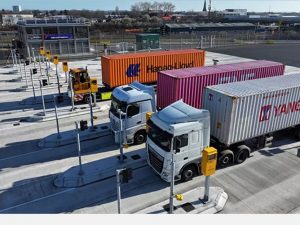Keku Bomi Gazder, MD and CEO, Aviapro Logistic Services said, “E-commerce, manufacturing, pharmaceuticals and agriculture are major sectors driving growth in domestic and international cargo transport. The rise of online shopping demands faster, more efficient logistics. Manufacturing exports, especially in electronics and automotive parts, boost freight volumes. Pharmaceuticals contribute significantly to air cargo due to strict timelines and temperature controls. Additionally, agricultural exports benefit from expanding cold chain infrastructure. Government initiatives like dedicated freight corridors and port modernisation enhance overall logistics efficiency. International trade recovery and global supply chain diversification also support cargo growth, making these sectors central to the evolving landscape of freight transportation.”
Read More »‘Steel, cement & auto contribute to hiked bulk & containerised cargo volumes’
Vandana Singh, Chairwoman, FAII said, “The rise in industrial activity, led by sectors like steel, cement and automotive has contributed significantly to bulk and containerised cargo volumes. The ‘Make in India’ initiative and PLI schemes have further boosted freight demand across corridors. With a push towards doubling farmers’ income, agricultural exports — especially perishables — are growing. This is driving investment in cold chain infrastructure and refrigerated logistics for both domestic distribution and overseas shipping. The boom in e-commerce is shaping the demand for air cargo, first-mile and last-mile logistics and high-speed parcel movement, particularly in Tier II and Tier III cities. India’s role as a global pharma hub has led to a significant increase in export cargo, necessitating temperature-controlled logistics and faster customs clearances through dedicated air cargo terminals. As a traditional export strength, the textile sector continues to drive outbound cargo to global fashion markets, particularly in Europe and the US. Domestic cargo volumes are also growing due to increased movement of coal, petroleum and other minerals through coastal shipping and rail networks. Together, these sectors are not only accelerating the demand for multimodal infrastructure but are also encouraging private participation and innovation in India’s logistics landscape. As connectivity improves under Gati Shakti, the cargo sector is set to become a key pillar of India’s economic growth and global trade competitiveness.”
Read More »‘E-commerce, pharma, electronics, auto, agri driving EXIM growth’
Balagopal Balachandran, National Head- Air Freight, FEI Cargo said, “India’s cargo transport landscape both domestic and international is witnessing accelerated growth. Internationally, sectors such as E and industrial manufacturing are leading the surge. On the domestic front, demand for time-sensitive logistics is being fuelled by e-commerce, FMCG, pharma etc. Gati Shakti’s integrated multimodal connectivity is playing a vital role in supporting this sectoral growth, ensuring seamless, efficient and cost-effective cargo movement across the country. India’s cargo growth is the result of a well-aligned ecosystem: visionary infrastructure (PM Gati Shakti), digital transparency (ULIP), and vibrant sectors scaling across borders. India is fast establishing itself as a global logistics powerhouse.”
Read More »‘Govt’s push for FTAs, trade facilitation & digital infra foster EXIM trade’
Amit Maheshwari, Founder and CEO, Softlink Global said, “Sectors like pharmaceuticals, e-commerce, auto components and electronics are propelling domestic cargo growth. Internationally, exports in engineering goods, chemicals and agri-products are expanding global cargo routes. The government’s push for FTAs, trade facilitation and digital infrastructure is enabling Indian freight forwarders to integrate more efficiently into global supply chains. Platforms like Logi-Sys, designed for the complexities of multimodal freight, are helping logistics providers manage this surge with better visibility, automation and compliance—making them future-ready in a fast-evolving cargo landscape.”
Read More »DP World unveils new programme to cut freight emissions
DP World has launched a new programme to cut freight emissions by incentivising trucks to transition to low-carbon fuels. The low-carbon truck programme (LCTP) will be trialled until 2027 at DP World’s London Gateway and Southampton logistics hubs. More than 4,000 truck visits take place at the two UK Ports and DP World is aiming to switch 500 vehicles to Hydrotreated Vegetable Oil (HVO). The alternative fuel has a carbon intensity 85% lower than diesel. DP World is ensuring that the HVO is offered at the same cost as diesel to help with uptake. The logistics company is working with fuel providers Certas Energy and New Era Fuels to create the HVO supply. The programme will target loaded trucks that visit DP World UK ports more than 90 times over a three-month period. Vehicles that meet these parameters will qualify for up to 5,000 litres of HVO per vehicle per port.
Read More »Vizhinjam port handles 1 mn TEUs of cargo in nine months
Vizhinjam port has handled 1 million TEUs (20-foot Equivalent Units) of cargo within just nine months of commencing commercial operations. According to the concession agreement, the projected handling capacity for the first year was three lakh containers. Vizhinjam has already surpassed this target, with current figures reaching 1.012 million TEUs, more than three times the original estimate. “Vizhinjam International Seaport has achieved a world-class milestone, providing all of us with a reason to celebrate Onam with pride,” said V N Vasavan, Ports Minister. “Vizhinjam has astonished the global maritime industry. To our knowledge, very few ports worldwide have exceeded their established capacity in the first year of operation.”
Read More »BLR Airport achieves level 2 accessibility enhancement accreditation by ACI
Kempegowda International Airport Bengaluru (BLR Airport) has been awarded the Level 2 Accreditation under the Airports Council International (ACI) Accessibility Enhancement Accreditation program, making it the first airport in India and among a select group of airports globally to reach this milestone. This recognition highlights BLR Airport’s commitment to building a truly inclusive travel environment — where infrastructure, technology and human touch come together to empower every traveller. Awarded under the Accessibility Enhancement Accreditation (AEA) Program, the world’s only initiative dedicated to benchmarking and advancing accessibility in aviation, this program by ACI assesses airports on facilities, services, and governance, recognising continuous improvements that embed accessibility into strategies, policies, and passenger experiences. Satyaki Raghunath, Chief Operating Officer, Bangalore International Airport Ltd said, “We are honoured to be awarded the Level 2 Accreditation under ACI’s Airport Accessibility Enhancement programme. At BLR Airport, accessibility is not just a measure of infrastructure, but a reflection of our belief that travel should be inclusive, seamless and experiential for every passenger. This milestone is the result of the tireless dedication of our entire team and the invaluable guidance from ACI, reinforcing our vision of building an airport that truly serves everyone. While we celebrate this achievement, we see it as a step forward in our continuous journey to make every traveller feel welcomed and valued at BLR Airport.”
Read More »Rajkot’s Hirasar Int’l Airport begins air cargo operations
Rajkot’s Hirasar International Airport have officially started air cargo operations. A senior official from Rajkot International Airport confirmed, “Air India began outbound cargo services from Rajkot and IndiGo is scheduled to start operations on 29 August,” said Mayur Adesra, President of the Gems and Jewellery Association, Rajkot. He added, “Our region is home to 8,000 to 10,000 wholesalers who regularly ship precious metal ornaments across India. Direct air cargo from Rajkot will significantly reduce transit time—by up to two days depending on the destination.” The added expense of private security was often unavoidable, given Rajkot’s status as a major hub for silver, gold and imitation jewellery, with daily consignments dispatched nationwide.
Read More »AP begins air cargo service from Donyi Polo Airport
Arunachal Pradesh is all set to begin its first outbound air cargo service from Donyi Polo Airport, Itanagar. The service, under the theme ‘Empowering Farmers, Connecting Markets,’ is designed to link local farmers with larger markets and speed up the transport of perishable goods. “Today, I had the privilege to flag off the first outbound air cargo from our state at Donyi Polo Airport. This initiative will open new horizons for our hardworking farmers,” Balo Raja, Civil Aviation Minister said in a post on X. As per the officials, the facility will focus on fruits, vegetables, flowers and other produce that often incur losses due to delays in conventional transport. The cargo service is expected to reduce wastage and help cultivators secure better prices, particularly in remote districts.
Read More »NMIA promises integrated terminal with 79 cargo stands in Phase 1
The Navi Mumbai International Airport (NMIA), gearing up for its inauguration in September, has announced the readiness of its Phase 1 facilities. On the cargo side, NMIA will feature an integrated terminal with 79 dedicated stands, equipped for semi-automated handling, cold chain logistics, specialised storage for perishables and hazardous goods, along with 100 per cent export screening. Its strategic location—just 14 km from Jawaharlal Nehru Port Trust—will facilitate seamless multimodal freight movement. Officials noted that the airport’s phased development strategy is aligned with projected air traffic growth. By 2050, passenger numbers in the Mumbai Metropolitan Region are expected to reach 250 million annually, with NMIA alone designed to handle up to 90 million passengers per year while ensuring robust capacity for cargo and private aviation. Phase 1 also includes parking for 42 commercial aircraft stands and 23 dedicated slots for private jets and general aviation, addressing a long-standing shortage of private aircraft parking in the region.
Read More » Cargo Breaking News
Cargo Breaking News









